Report: Adelaide Railway Station Refurbishment Project Analysis
VerifiedAdded on 2023/01/03
|11
|2930
|89
Report
AI Summary
This report provides a comprehensive analysis of the Adelaide railway station refurbishment project, initiated in 2012 and completed by 2015, focusing on its conceptual design phase. The project aimed to enhance public transportation facilities, addressing stakeholder needs including the community, passengers, employees, and commercial sectors. The report details the stakeholder needs assessment, the conceptual design process involving various departments and partners, and the system requirements necessary for the project's success. It highlights the importance of resource utilization, risk assessment, and financial planning in the design process, as well as the integration of various upgrades like escalators, signage systems, and retail offerings. The report also discusses the project's adherence to legal requirements, the consideration of alternative design approaches, and the significance of feedback mechanisms from the public. The conclusion underscores the project's success in improving service quality and public utility, and its contribution to the overall enhancement of Adelaide's railway network.
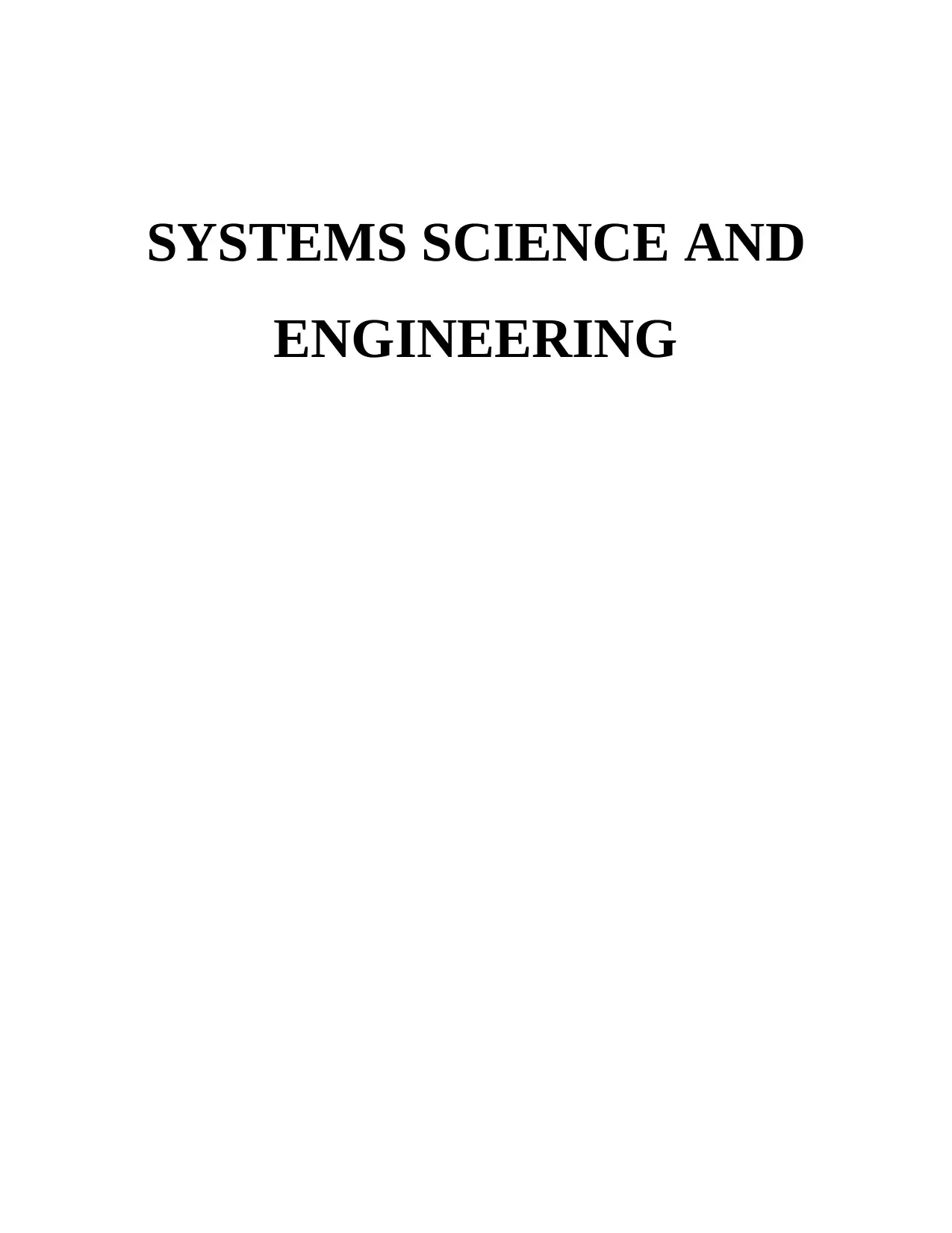
SYSTEMS SCIENCE AND
ENGINEERING
ENGINEERING
Paraphrase This Document
Need a fresh take? Get an instant paraphrase of this document with our AI Paraphraser

CONTENTS
INTRODUCTION...........................................................................................................................1
STAKEHOLDER NEEDS..............................................................................................................1
CONCEPTUAL DESIGN PROCESS.............................................................................................2
SYSTEM REQUIREMENTS..........................................................................................................5
CONCLUSION................................................................................................................................6
REFERENCES................................................................................................................................7
INTRODUCTION...........................................................................................................................1
STAKEHOLDER NEEDS..............................................................................................................1
CONCEPTUAL DESIGN PROCESS.............................................................................................2
SYSTEM REQUIREMENTS..........................................................................................................5
CONCLUSION................................................................................................................................6
REFERENCES................................................................................................................................7
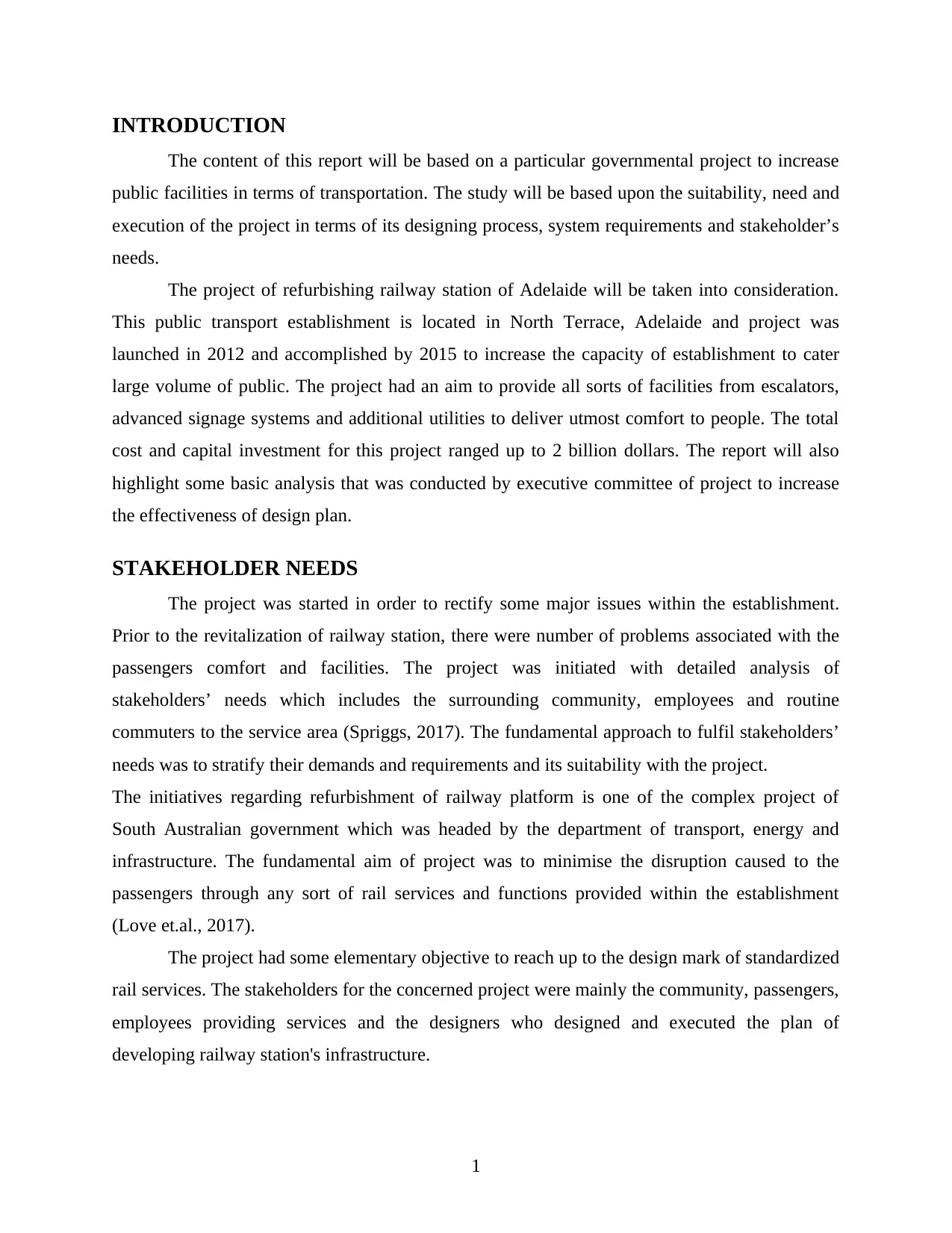
INTRODUCTION
The content of this report will be based on a particular governmental project to increase
public facilities in terms of transportation. The study will be based upon the suitability, need and
execution of the project in terms of its designing process, system requirements and stakeholder’s
needs.
The project of refurbishing railway station of Adelaide will be taken into consideration.
This public transport establishment is located in North Terrace, Adelaide and project was
launched in 2012 and accomplished by 2015 to increase the capacity of establishment to cater
large volume of public. The project had an aim to provide all sorts of facilities from escalators,
advanced signage systems and additional utilities to deliver utmost comfort to people. The total
cost and capital investment for this project ranged up to 2 billion dollars. The report will also
highlight some basic analysis that was conducted by executive committee of project to increase
the effectiveness of design plan.
STAKEHOLDER NEEDS
The project was started in order to rectify some major issues within the establishment.
Prior to the revitalization of railway station, there were number of problems associated with the
passengers comfort and facilities. The project was initiated with detailed analysis of
stakeholders’ needs which includes the surrounding community, employees and routine
commuters to the service area (Spriggs, 2017). The fundamental approach to fulfil stakeholders’
needs was to stratify their demands and requirements and its suitability with the project.
The initiatives regarding refurbishment of railway platform is one of the complex project of
South Australian government which was headed by the department of transport, energy and
infrastructure. The fundamental aim of project was to minimise the disruption caused to the
passengers through any sort of rail services and functions provided within the establishment
(Love et.al., 2017).
The project had some elementary objective to reach up to the design mark of standardized
rail services. The stakeholders for the concerned project were mainly the community, passengers,
employees providing services and the designers who designed and executed the plan of
developing railway station's infrastructure.
1
The content of this report will be based on a particular governmental project to increase
public facilities in terms of transportation. The study will be based upon the suitability, need and
execution of the project in terms of its designing process, system requirements and stakeholder’s
needs.
The project of refurbishing railway station of Adelaide will be taken into consideration.
This public transport establishment is located in North Terrace, Adelaide and project was
launched in 2012 and accomplished by 2015 to increase the capacity of establishment to cater
large volume of public. The project had an aim to provide all sorts of facilities from escalators,
advanced signage systems and additional utilities to deliver utmost comfort to people. The total
cost and capital investment for this project ranged up to 2 billion dollars. The report will also
highlight some basic analysis that was conducted by executive committee of project to increase
the effectiveness of design plan.
STAKEHOLDER NEEDS
The project was started in order to rectify some major issues within the establishment.
Prior to the revitalization of railway station, there were number of problems associated with the
passengers comfort and facilities. The project was initiated with detailed analysis of
stakeholders’ needs which includes the surrounding community, employees and routine
commuters to the service area (Spriggs, 2017). The fundamental approach to fulfil stakeholders’
needs was to stratify their demands and requirements and its suitability with the project.
The initiatives regarding refurbishment of railway platform is one of the complex project of
South Australian government which was headed by the department of transport, energy and
infrastructure. The fundamental aim of project was to minimise the disruption caused to the
passengers through any sort of rail services and functions provided within the establishment
(Love et.al., 2017).
The project had some elementary objective to reach up to the design mark of standardized
rail services. The stakeholders for the concerned project were mainly the community, passengers,
employees providing services and the designers who designed and executed the plan of
developing railway station's infrastructure.
1
⊘ This is a preview!⊘
Do you want full access?
Subscribe today to unlock all pages.

Trusted by 1+ million students worldwide
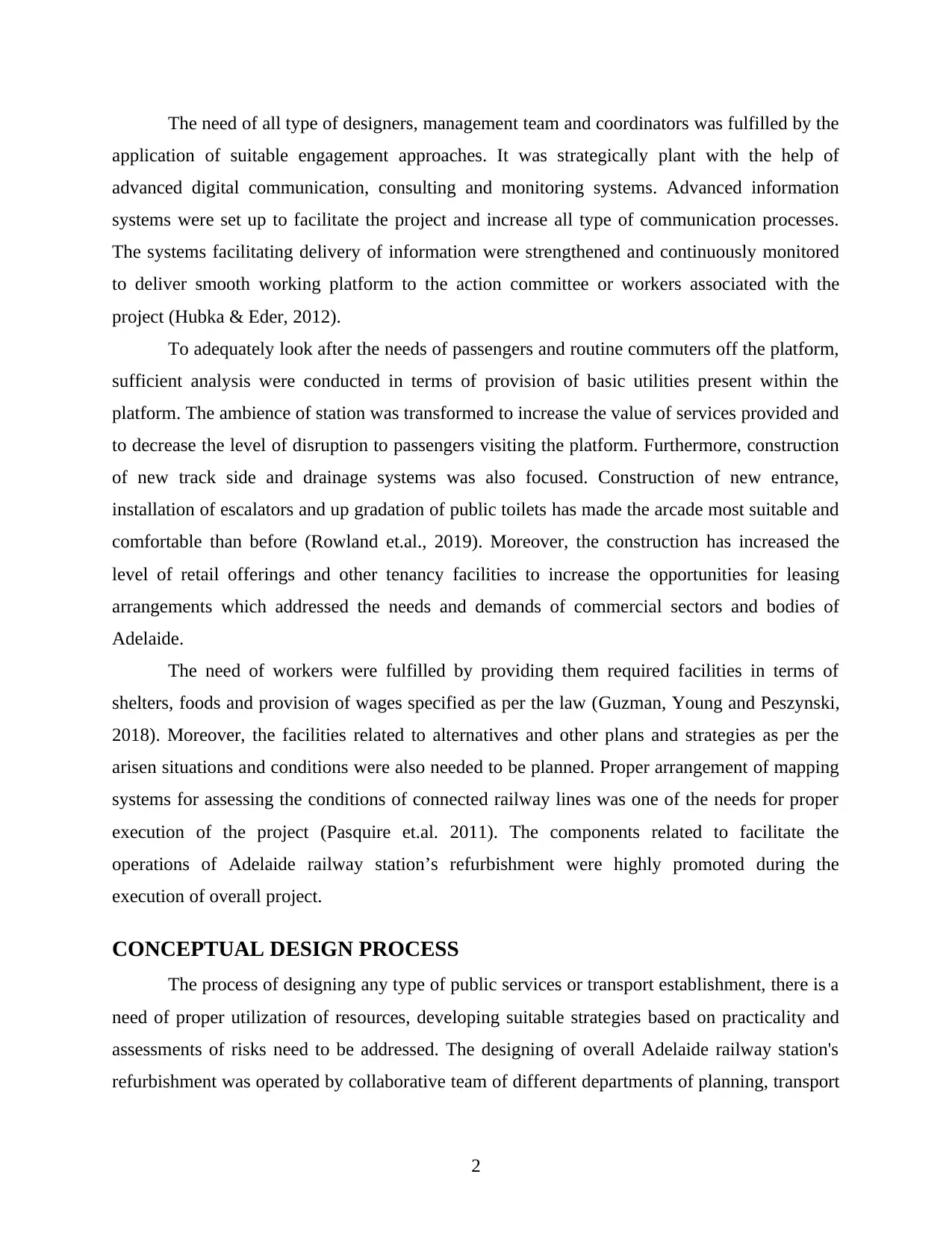
The need of all type of designers, management team and coordinators was fulfilled by the
application of suitable engagement approaches. It was strategically plant with the help of
advanced digital communication, consulting and monitoring systems. Advanced information
systems were set up to facilitate the project and increase all type of communication processes.
The systems facilitating delivery of information were strengthened and continuously monitored
to deliver smooth working platform to the action committee or workers associated with the
project (Hubka & Eder, 2012).
To adequately look after the needs of passengers and routine commuters off the platform,
sufficient analysis were conducted in terms of provision of basic utilities present within the
platform. The ambience of station was transformed to increase the value of services provided and
to decrease the level of disruption to passengers visiting the platform. Furthermore, construction
of new track side and drainage systems was also focused. Construction of new entrance,
installation of escalators and up gradation of public toilets has made the arcade most suitable and
comfortable than before (Rowland et.al., 2019). Moreover, the construction has increased the
level of retail offerings and other tenancy facilities to increase the opportunities for leasing
arrangements which addressed the needs and demands of commercial sectors and bodies of
Adelaide.
The need of workers were fulfilled by providing them required facilities in terms of
shelters, foods and provision of wages specified as per the law (Guzman, Young and Peszynski,
2018). Moreover, the facilities related to alternatives and other plans and strategies as per the
arisen situations and conditions were also needed to be planned. Proper arrangement of mapping
systems for assessing the conditions of connected railway lines was one of the needs for proper
execution of the project (Pasquire et.al. 2011). The components related to facilitate the
operations of Adelaide railway station’s refurbishment were highly promoted during the
execution of overall project.
CONCEPTUAL DESIGN PROCESS
The process of designing any type of public services or transport establishment, there is a
need of proper utilization of resources, developing suitable strategies based on practicality and
assessments of risks need to be addressed. The designing of overall Adelaide railway station's
refurbishment was operated by collaborative team of different departments of planning, transport
2
application of suitable engagement approaches. It was strategically plant with the help of
advanced digital communication, consulting and monitoring systems. Advanced information
systems were set up to facilitate the project and increase all type of communication processes.
The systems facilitating delivery of information were strengthened and continuously monitored
to deliver smooth working platform to the action committee or workers associated with the
project (Hubka & Eder, 2012).
To adequately look after the needs of passengers and routine commuters off the platform,
sufficient analysis were conducted in terms of provision of basic utilities present within the
platform. The ambience of station was transformed to increase the value of services provided and
to decrease the level of disruption to passengers visiting the platform. Furthermore, construction
of new track side and drainage systems was also focused. Construction of new entrance,
installation of escalators and up gradation of public toilets has made the arcade most suitable and
comfortable than before (Rowland et.al., 2019). Moreover, the construction has increased the
level of retail offerings and other tenancy facilities to increase the opportunities for leasing
arrangements which addressed the needs and demands of commercial sectors and bodies of
Adelaide.
The need of workers were fulfilled by providing them required facilities in terms of
shelters, foods and provision of wages specified as per the law (Guzman, Young and Peszynski,
2018). Moreover, the facilities related to alternatives and other plans and strategies as per the
arisen situations and conditions were also needed to be planned. Proper arrangement of mapping
systems for assessing the conditions of connected railway lines was one of the needs for proper
execution of the project (Pasquire et.al. 2011). The components related to facilitate the
operations of Adelaide railway station’s refurbishment were highly promoted during the
execution of overall project.
CONCEPTUAL DESIGN PROCESS
The process of designing any type of public services or transport establishment, there is a
need of proper utilization of resources, developing suitable strategies based on practicality and
assessments of risks need to be addressed. The designing of overall Adelaide railway station's
refurbishment was operated by collaborative team of different departments of planning, transport
2
Paraphrase This Document
Need a fresh take? Get an instant paraphrase of this document with our AI Paraphraser
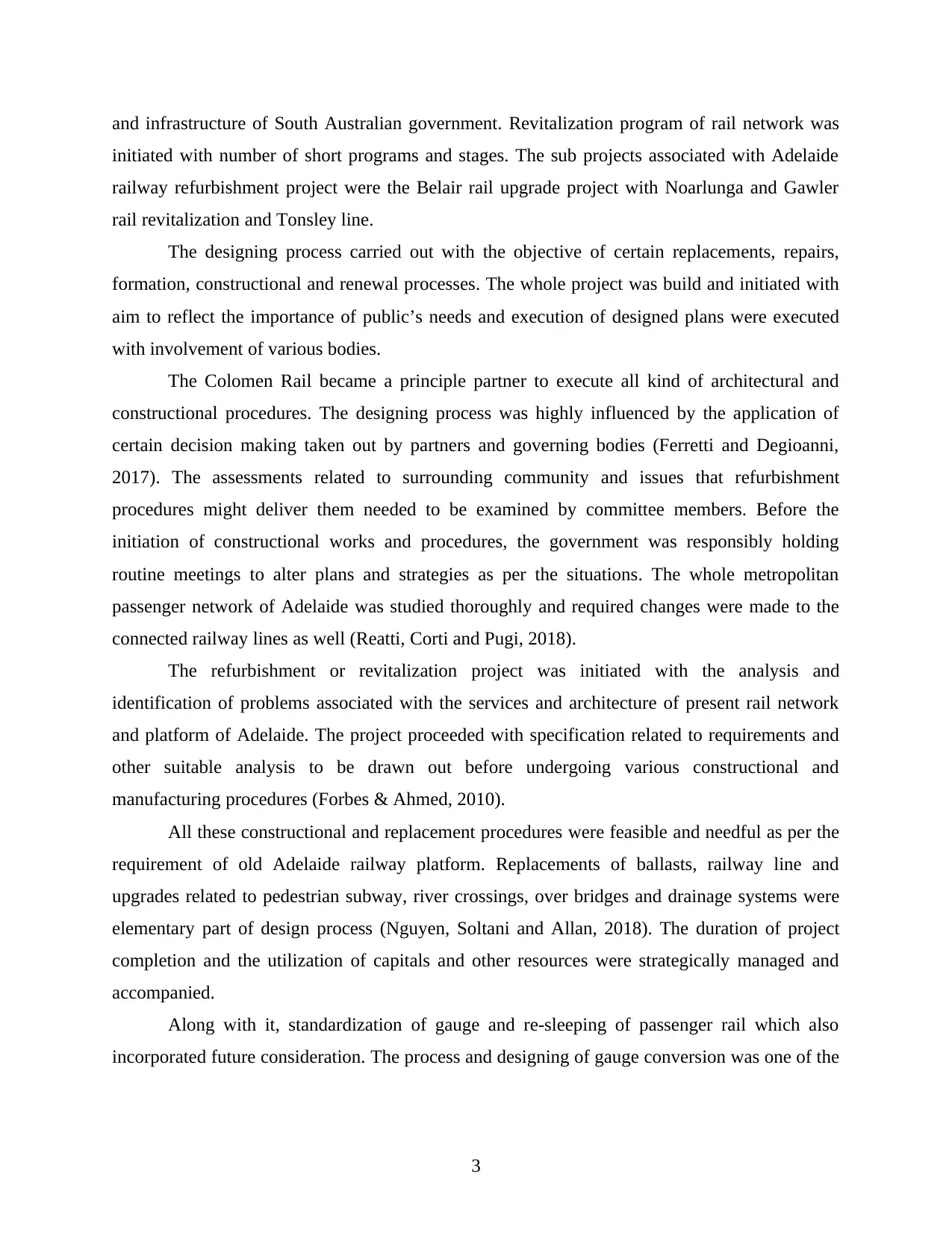
and infrastructure of South Australian government. Revitalization program of rail network was
initiated with number of short programs and stages. The sub projects associated with Adelaide
railway refurbishment project were the Belair rail upgrade project with Noarlunga and Gawler
rail revitalization and Tonsley line.
The designing process carried out with the objective of certain replacements, repairs,
formation, constructional and renewal processes. The whole project was build and initiated with
aim to reflect the importance of public’s needs and execution of designed plans were executed
with involvement of various bodies.
The Colomen Rail became a principle partner to execute all kind of architectural and
constructional procedures. The designing process was highly influenced by the application of
certain decision making taken out by partners and governing bodies (Ferretti and Degioanni,
2017). The assessments related to surrounding community and issues that refurbishment
procedures might deliver them needed to be examined by committee members. Before the
initiation of constructional works and procedures, the government was responsibly holding
routine meetings to alter plans and strategies as per the situations. The whole metropolitan
passenger network of Adelaide was studied thoroughly and required changes were made to the
connected railway lines as well (Reatti, Corti and Pugi, 2018).
The refurbishment or revitalization project was initiated with the analysis and
identification of problems associated with the services and architecture of present rail network
and platform of Adelaide. The project proceeded with specification related to requirements and
other suitable analysis to be drawn out before undergoing various constructional and
manufacturing procedures (Forbes & Ahmed, 2010).
All these constructional and replacement procedures were feasible and needful as per the
requirement of old Adelaide railway platform. Replacements of ballasts, railway line and
upgrades related to pedestrian subway, river crossings, over bridges and drainage systems were
elementary part of design process (Nguyen, Soltani and Allan, 2018). The duration of project
completion and the utilization of capitals and other resources were strategically managed and
accompanied.
Along with it, standardization of gauge and re-sleeping of passenger rail which also
incorporated future consideration. The process and designing of gauge conversion was one of the
3
initiated with number of short programs and stages. The sub projects associated with Adelaide
railway refurbishment project were the Belair rail upgrade project with Noarlunga and Gawler
rail revitalization and Tonsley line.
The designing process carried out with the objective of certain replacements, repairs,
formation, constructional and renewal processes. The whole project was build and initiated with
aim to reflect the importance of public’s needs and execution of designed plans were executed
with involvement of various bodies.
The Colomen Rail became a principle partner to execute all kind of architectural and
constructional procedures. The designing process was highly influenced by the application of
certain decision making taken out by partners and governing bodies (Ferretti and Degioanni,
2017). The assessments related to surrounding community and issues that refurbishment
procedures might deliver them needed to be examined by committee members. Before the
initiation of constructional works and procedures, the government was responsibly holding
routine meetings to alter plans and strategies as per the situations. The whole metropolitan
passenger network of Adelaide was studied thoroughly and required changes were made to the
connected railway lines as well (Reatti, Corti and Pugi, 2018).
The refurbishment or revitalization project was initiated with the analysis and
identification of problems associated with the services and architecture of present rail network
and platform of Adelaide. The project proceeded with specification related to requirements and
other suitable analysis to be drawn out before undergoing various constructional and
manufacturing procedures (Forbes & Ahmed, 2010).
All these constructional and replacement procedures were feasible and needful as per the
requirement of old Adelaide railway platform. Replacements of ballasts, railway line and
upgrades related to pedestrian subway, river crossings, over bridges and drainage systems were
elementary part of design process (Nguyen, Soltani and Allan, 2018). The duration of project
completion and the utilization of capitals and other resources were strategically managed and
accompanied.
Along with it, standardization of gauge and re-sleeping of passenger rail which also
incorporated future consideration. The process and designing of gauge conversion was one of the
3
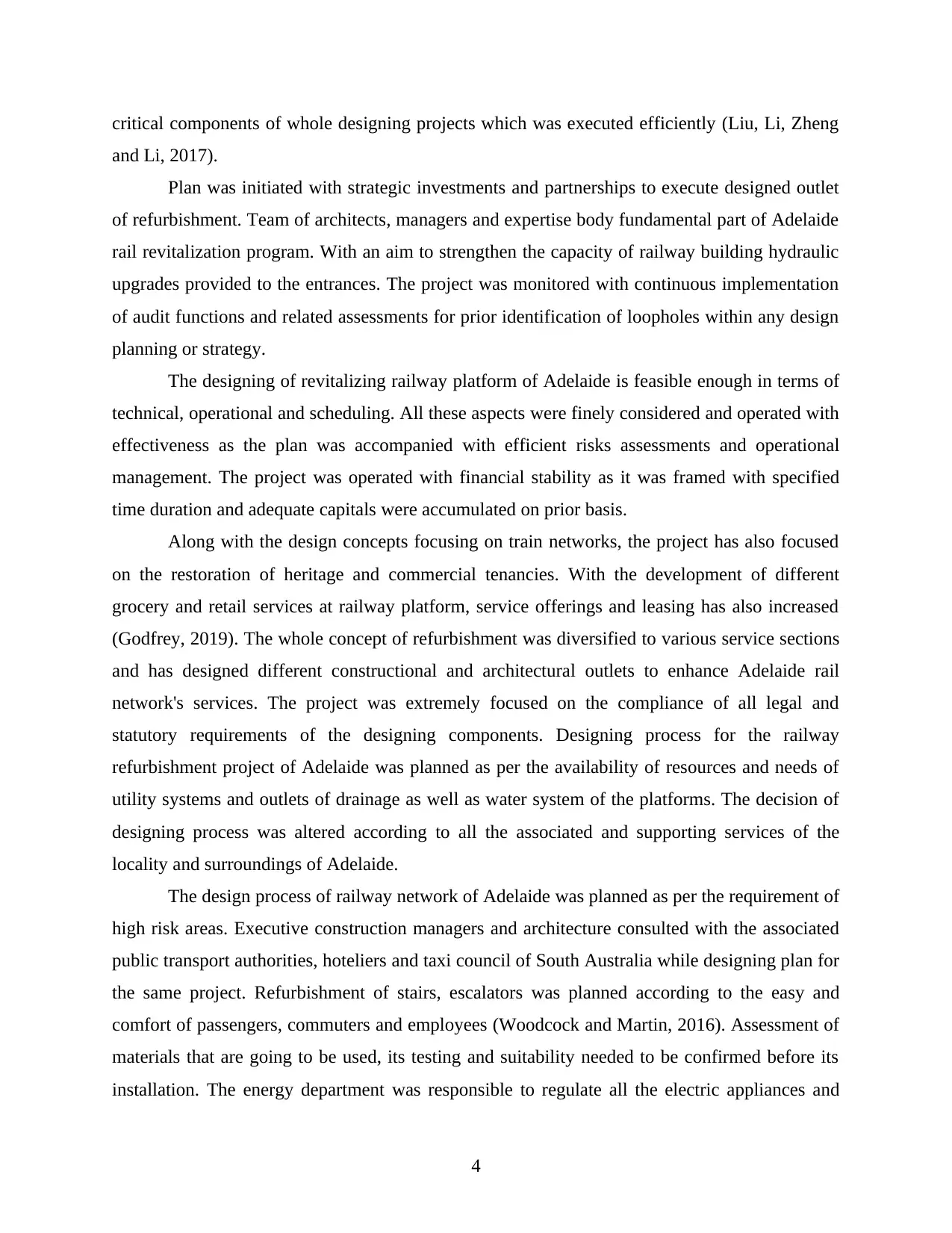
critical components of whole designing projects which was executed efficiently (Liu, Li, Zheng
and Li, 2017).
Plan was initiated with strategic investments and partnerships to execute designed outlet
of refurbishment. Team of architects, managers and expertise body fundamental part of Adelaide
rail revitalization program. With an aim to strengthen the capacity of railway building hydraulic
upgrades provided to the entrances. The project was monitored with continuous implementation
of audit functions and related assessments for prior identification of loopholes within any design
planning or strategy.
The designing of revitalizing railway platform of Adelaide is feasible enough in terms of
technical, operational and scheduling. All these aspects were finely considered and operated with
effectiveness as the plan was accompanied with efficient risks assessments and operational
management. The project was operated with financial stability as it was framed with specified
time duration and adequate capitals were accumulated on prior basis.
Along with the design concepts focusing on train networks, the project has also focused
on the restoration of heritage and commercial tenancies. With the development of different
grocery and retail services at railway platform, service offerings and leasing has also increased
(Godfrey, 2019). The whole concept of refurbishment was diversified to various service sections
and has designed different constructional and architectural outlets to enhance Adelaide rail
network's services. The project was extremely focused on the compliance of all legal and
statutory requirements of the designing components. Designing process for the railway
refurbishment project of Adelaide was planned as per the availability of resources and needs of
utility systems and outlets of drainage as well as water system of the platforms. The decision of
designing process was altered according to all the associated and supporting services of the
locality and surroundings of Adelaide.
The design process of railway network of Adelaide was planned as per the requirement of
high risk areas. Executive construction managers and architecture consulted with the associated
public transport authorities, hoteliers and taxi council of South Australia while designing plan for
the same project. Refurbishment of stairs, escalators was planned according to the easy and
comfort of passengers, commuters and employees (Woodcock and Martin, 2016). Assessment of
materials that are going to be used, its testing and suitability needed to be confirmed before its
installation. The energy department was responsible to regulate all the electric appliances and
4
and Li, 2017).
Plan was initiated with strategic investments and partnerships to execute designed outlet
of refurbishment. Team of architects, managers and expertise body fundamental part of Adelaide
rail revitalization program. With an aim to strengthen the capacity of railway building hydraulic
upgrades provided to the entrances. The project was monitored with continuous implementation
of audit functions and related assessments for prior identification of loopholes within any design
planning or strategy.
The designing of revitalizing railway platform of Adelaide is feasible enough in terms of
technical, operational and scheduling. All these aspects were finely considered and operated with
effectiveness as the plan was accompanied with efficient risks assessments and operational
management. The project was operated with financial stability as it was framed with specified
time duration and adequate capitals were accumulated on prior basis.
Along with the design concepts focusing on train networks, the project has also focused
on the restoration of heritage and commercial tenancies. With the development of different
grocery and retail services at railway platform, service offerings and leasing has also increased
(Godfrey, 2019). The whole concept of refurbishment was diversified to various service sections
and has designed different constructional and architectural outlets to enhance Adelaide rail
network's services. The project was extremely focused on the compliance of all legal and
statutory requirements of the designing components. Designing process for the railway
refurbishment project of Adelaide was planned as per the availability of resources and needs of
utility systems and outlets of drainage as well as water system of the platforms. The decision of
designing process was altered according to all the associated and supporting services of the
locality and surroundings of Adelaide.
The design process of railway network of Adelaide was planned as per the requirement of
high risk areas. Executive construction managers and architecture consulted with the associated
public transport authorities, hoteliers and taxi council of South Australia while designing plan for
the same project. Refurbishment of stairs, escalators was planned according to the easy and
comfort of passengers, commuters and employees (Woodcock and Martin, 2016). Assessment of
materials that are going to be used, its testing and suitability needed to be confirmed before its
installation. The energy department was responsible to regulate all the electric appliances and
4
⊘ This is a preview!⊘
Do you want full access?
Subscribe today to unlock all pages.

Trusted by 1+ million students worldwide
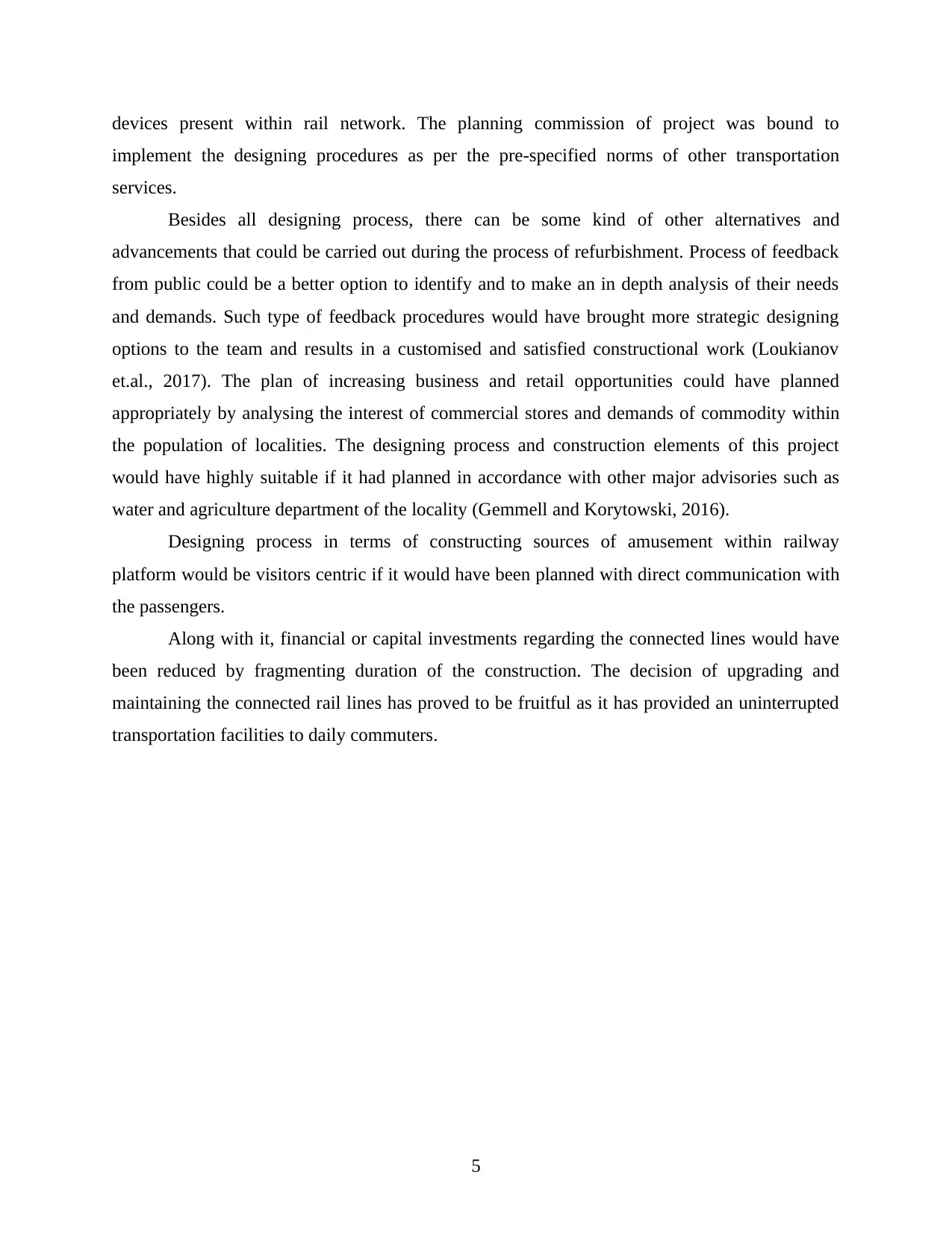
devices present within rail network. The planning commission of project was bound to
implement the designing procedures as per the pre-specified norms of other transportation
services.
Besides all designing process, there can be some kind of other alternatives and
advancements that could be carried out during the process of refurbishment. Process of feedback
from public could be a better option to identify and to make an in depth analysis of their needs
and demands. Such type of feedback procedures would have brought more strategic designing
options to the team and results in a customised and satisfied constructional work (Loukianov
et.al., 2017). The plan of increasing business and retail opportunities could have planned
appropriately by analysing the interest of commercial stores and demands of commodity within
the population of localities. The designing process and construction elements of this project
would have highly suitable if it had planned in accordance with other major advisories such as
water and agriculture department of the locality (Gemmell and Korytowski, 2016).
Designing process in terms of constructing sources of amusement within railway
platform would be visitors centric if it would have been planned with direct communication with
the passengers.
Along with it, financial or capital investments regarding the connected lines would have
been reduced by fragmenting duration of the construction. The decision of upgrading and
maintaining the connected rail lines has proved to be fruitful as it has provided an uninterrupted
transportation facilities to daily commuters.
5
implement the designing procedures as per the pre-specified norms of other transportation
services.
Besides all designing process, there can be some kind of other alternatives and
advancements that could be carried out during the process of refurbishment. Process of feedback
from public could be a better option to identify and to make an in depth analysis of their needs
and demands. Such type of feedback procedures would have brought more strategic designing
options to the team and results in a customised and satisfied constructional work (Loukianov
et.al., 2017). The plan of increasing business and retail opportunities could have planned
appropriately by analysing the interest of commercial stores and demands of commodity within
the population of localities. The designing process and construction elements of this project
would have highly suitable if it had planned in accordance with other major advisories such as
water and agriculture department of the locality (Gemmell and Korytowski, 2016).
Designing process in terms of constructing sources of amusement within railway
platform would be visitors centric if it would have been planned with direct communication with
the passengers.
Along with it, financial or capital investments regarding the connected lines would have
been reduced by fragmenting duration of the construction. The decision of upgrading and
maintaining the connected rail lines has proved to be fruitful as it has provided an uninterrupted
transportation facilities to daily commuters.
5
Paraphrase This Document
Need a fresh take? Get an instant paraphrase of this document with our AI Paraphraser
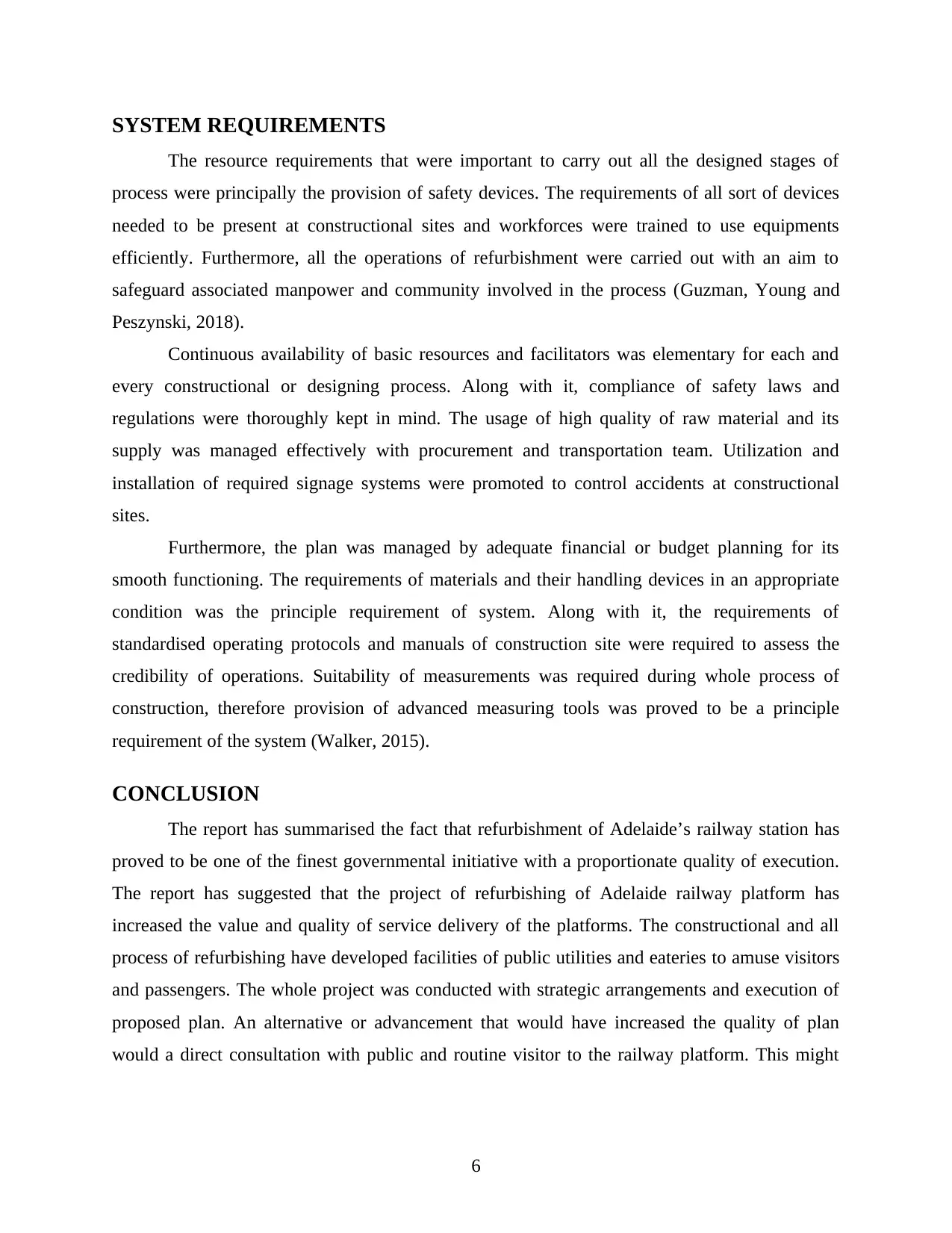
SYSTEM REQUIREMENTS
The resource requirements that were important to carry out all the designed stages of
process were principally the provision of safety devices. The requirements of all sort of devices
needed to be present at constructional sites and workforces were trained to use equipments
efficiently. Furthermore, all the operations of refurbishment were carried out with an aim to
safeguard associated manpower and community involved in the process (Guzman, Young and
Peszynski, 2018).
Continuous availability of basic resources and facilitators was elementary for each and
every constructional or designing process. Along with it, compliance of safety laws and
regulations were thoroughly kept in mind. The usage of high quality of raw material and its
supply was managed effectively with procurement and transportation team. Utilization and
installation of required signage systems were promoted to control accidents at constructional
sites.
Furthermore, the plan was managed by adequate financial or budget planning for its
smooth functioning. The requirements of materials and their handling devices in an appropriate
condition was the principle requirement of system. Along with it, the requirements of
standardised operating protocols and manuals of construction site were required to assess the
credibility of operations. Suitability of measurements was required during whole process of
construction, therefore provision of advanced measuring tools was proved to be a principle
requirement of the system (Walker, 2015).
CONCLUSION
The report has summarised the fact that refurbishment of Adelaide’s railway station has
proved to be one of the finest governmental initiative with a proportionate quality of execution.
The report has suggested that the project of refurbishing of Adelaide railway platform has
increased the value and quality of service delivery of the platforms. The constructional and all
process of refurbishing have developed facilities of public utilities and eateries to amuse visitors
and passengers. The whole project was conducted with strategic arrangements and execution of
proposed plan. An alternative or advancement that would have increased the quality of plan
would a direct consultation with public and routine visitor to the railway platform. This might
6
The resource requirements that were important to carry out all the designed stages of
process were principally the provision of safety devices. The requirements of all sort of devices
needed to be present at constructional sites and workforces were trained to use equipments
efficiently. Furthermore, all the operations of refurbishment were carried out with an aim to
safeguard associated manpower and community involved in the process (Guzman, Young and
Peszynski, 2018).
Continuous availability of basic resources and facilitators was elementary for each and
every constructional or designing process. Along with it, compliance of safety laws and
regulations were thoroughly kept in mind. The usage of high quality of raw material and its
supply was managed effectively with procurement and transportation team. Utilization and
installation of required signage systems were promoted to control accidents at constructional
sites.
Furthermore, the plan was managed by adequate financial or budget planning for its
smooth functioning. The requirements of materials and their handling devices in an appropriate
condition was the principle requirement of system. Along with it, the requirements of
standardised operating protocols and manuals of construction site were required to assess the
credibility of operations. Suitability of measurements was required during whole process of
construction, therefore provision of advanced measuring tools was proved to be a principle
requirement of the system (Walker, 2015).
CONCLUSION
The report has summarised the fact that refurbishment of Adelaide’s railway station has
proved to be one of the finest governmental initiative with a proportionate quality of execution.
The report has suggested that the project of refurbishing of Adelaide railway platform has
increased the value and quality of service delivery of the platforms. The constructional and all
process of refurbishing have developed facilities of public utilities and eateries to amuse visitors
and passengers. The whole project was conducted with strategic arrangements and execution of
proposed plan. An alternative or advancement that would have increased the quality of plan
would a direct consultation with public and routine visitor to the railway platform. This might
6

provide designers an accurate plan of design that needed to be introduced within the
establishment.
7
establishment.
7
⊘ This is a preview!⊘
Do you want full access?
Subscribe today to unlock all pages.

Trusted by 1+ million students worldwide
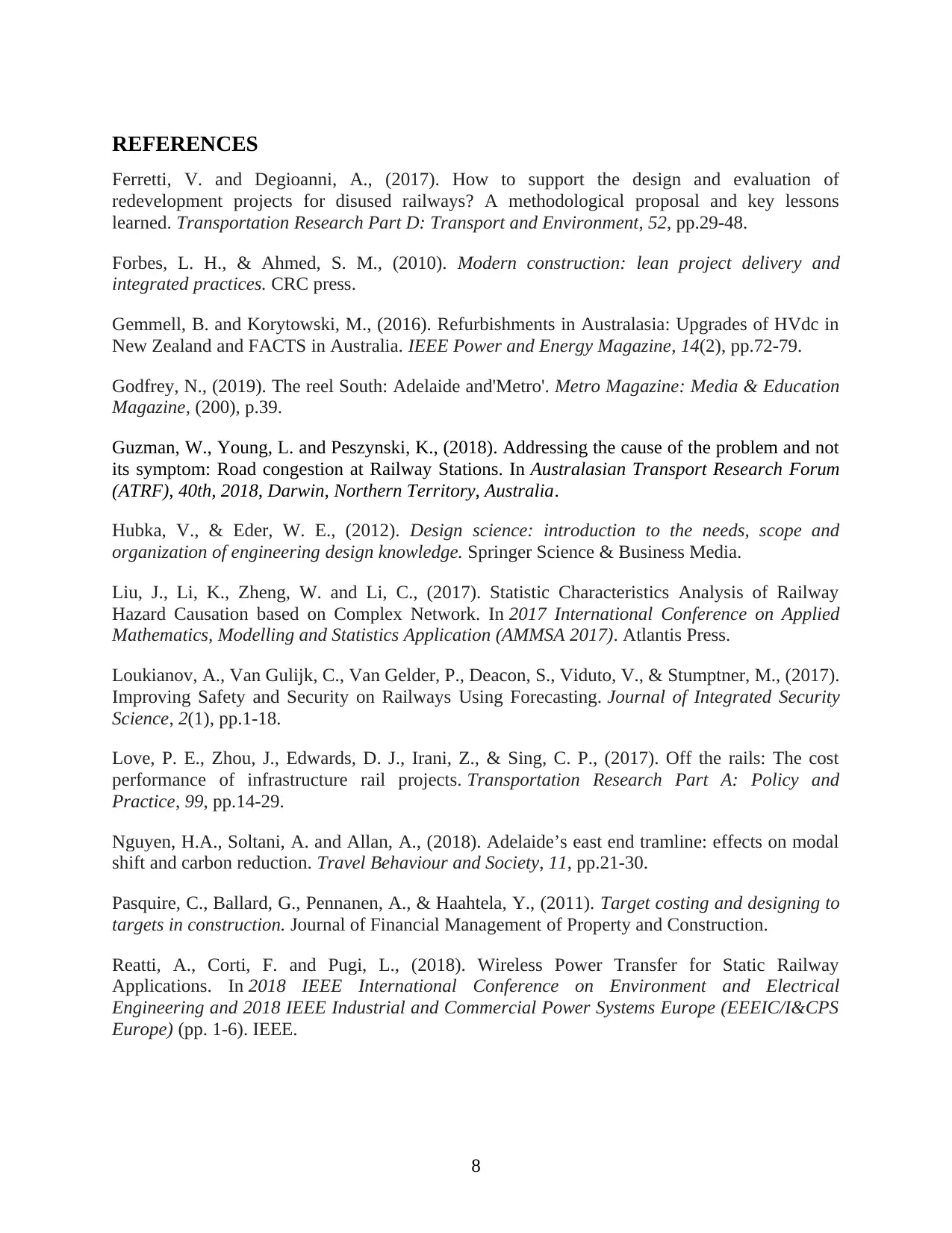
REFERENCES
Ferretti, V. and Degioanni, A., (2017). How to support the design and evaluation of
redevelopment projects for disused railways? A methodological proposal and key lessons
learned. Transportation Research Part D: Transport and Environment, 52, pp.29-48.
Forbes, L. H., & Ahmed, S. M., (2010). Modern construction: lean project delivery and
integrated practices. CRC press.
Gemmell, B. and Korytowski, M., (2016). Refurbishments in Australasia: Upgrades of HVdc in
New Zealand and FACTS in Australia. IEEE Power and Energy Magazine, 14(2), pp.72-79.
Godfrey, N., (2019). The reel South: Adelaide and'Metro'. Metro Magazine: Media & Education
Magazine, (200), p.39.
Guzman, W., Young, L. and Peszynski, K., (2018). Addressing the cause of the problem and not
its symptom: Road congestion at Railway Stations. In Australasian Transport Research Forum
(ATRF), 40th, 2018, Darwin, Northern Territory, Australia.
Hubka, V., & Eder, W. E., (2012). Design science: introduction to the needs, scope and
organization of engineering design knowledge. Springer Science & Business Media.
Liu, J., Li, K., Zheng, W. and Li, C., (2017). Statistic Characteristics Analysis of Railway
Hazard Causation based on Complex Network. In 2017 International Conference on Applied
Mathematics, Modelling and Statistics Application (AMMSA 2017). Atlantis Press.
Loukianov, A., Van Gulijk, C., Van Gelder, P., Deacon, S., Viduto, V., & Stumptner, M., (2017).
Improving Safety and Security on Railways Using Forecasting. Journal of Integrated Security
Science, 2(1), pp.1-18.
Love, P. E., Zhou, J., Edwards, D. J., Irani, Z., & Sing, C. P., (2017). Off the rails: The cost
performance of infrastructure rail projects. Transportation Research Part A: Policy and
Practice, 99, pp.14-29.
Nguyen, H.A., Soltani, A. and Allan, A., (2018). Adelaide’s east end tramline: effects on modal
shift and carbon reduction. Travel Behaviour and Society, 11, pp.21-30.
Pasquire, C., Ballard, G., Pennanen, A., & Haahtela, Y., (2011). Target costing and designing to
targets in construction. Journal of Financial Management of Property and Construction.
Reatti, A., Corti, F. and Pugi, L., (2018). Wireless Power Transfer for Static Railway
Applications. In 2018 IEEE International Conference on Environment and Electrical
Engineering and 2018 IEEE Industrial and Commercial Power Systems Europe (EEEIC/I&CPS
Europe) (pp. 1-6). IEEE.
8
Ferretti, V. and Degioanni, A., (2017). How to support the design and evaluation of
redevelopment projects for disused railways? A methodological proposal and key lessons
learned. Transportation Research Part D: Transport and Environment, 52, pp.29-48.
Forbes, L. H., & Ahmed, S. M., (2010). Modern construction: lean project delivery and
integrated practices. CRC press.
Gemmell, B. and Korytowski, M., (2016). Refurbishments in Australasia: Upgrades of HVdc in
New Zealand and FACTS in Australia. IEEE Power and Energy Magazine, 14(2), pp.72-79.
Godfrey, N., (2019). The reel South: Adelaide and'Metro'. Metro Magazine: Media & Education
Magazine, (200), p.39.
Guzman, W., Young, L. and Peszynski, K., (2018). Addressing the cause of the problem and not
its symptom: Road congestion at Railway Stations. In Australasian Transport Research Forum
(ATRF), 40th, 2018, Darwin, Northern Territory, Australia.
Hubka, V., & Eder, W. E., (2012). Design science: introduction to the needs, scope and
organization of engineering design knowledge. Springer Science & Business Media.
Liu, J., Li, K., Zheng, W. and Li, C., (2017). Statistic Characteristics Analysis of Railway
Hazard Causation based on Complex Network. In 2017 International Conference on Applied
Mathematics, Modelling and Statistics Application (AMMSA 2017). Atlantis Press.
Loukianov, A., Van Gulijk, C., Van Gelder, P., Deacon, S., Viduto, V., & Stumptner, M., (2017).
Improving Safety and Security on Railways Using Forecasting. Journal of Integrated Security
Science, 2(1), pp.1-18.
Love, P. E., Zhou, J., Edwards, D. J., Irani, Z., & Sing, C. P., (2017). Off the rails: The cost
performance of infrastructure rail projects. Transportation Research Part A: Policy and
Practice, 99, pp.14-29.
Nguyen, H.A., Soltani, A. and Allan, A., (2018). Adelaide’s east end tramline: effects on modal
shift and carbon reduction. Travel Behaviour and Society, 11, pp.21-30.
Pasquire, C., Ballard, G., Pennanen, A., & Haahtela, Y., (2011). Target costing and designing to
targets in construction. Journal of Financial Management of Property and Construction.
Reatti, A., Corti, F. and Pugi, L., (2018). Wireless Power Transfer for Static Railway
Applications. In 2018 IEEE International Conference on Environment and Electrical
Engineering and 2018 IEEE Industrial and Commercial Power Systems Europe (EEEIC/I&CPS
Europe) (pp. 1-6). IEEE.
8
Paraphrase This Document
Need a fresh take? Get an instant paraphrase of this document with our AI Paraphraser
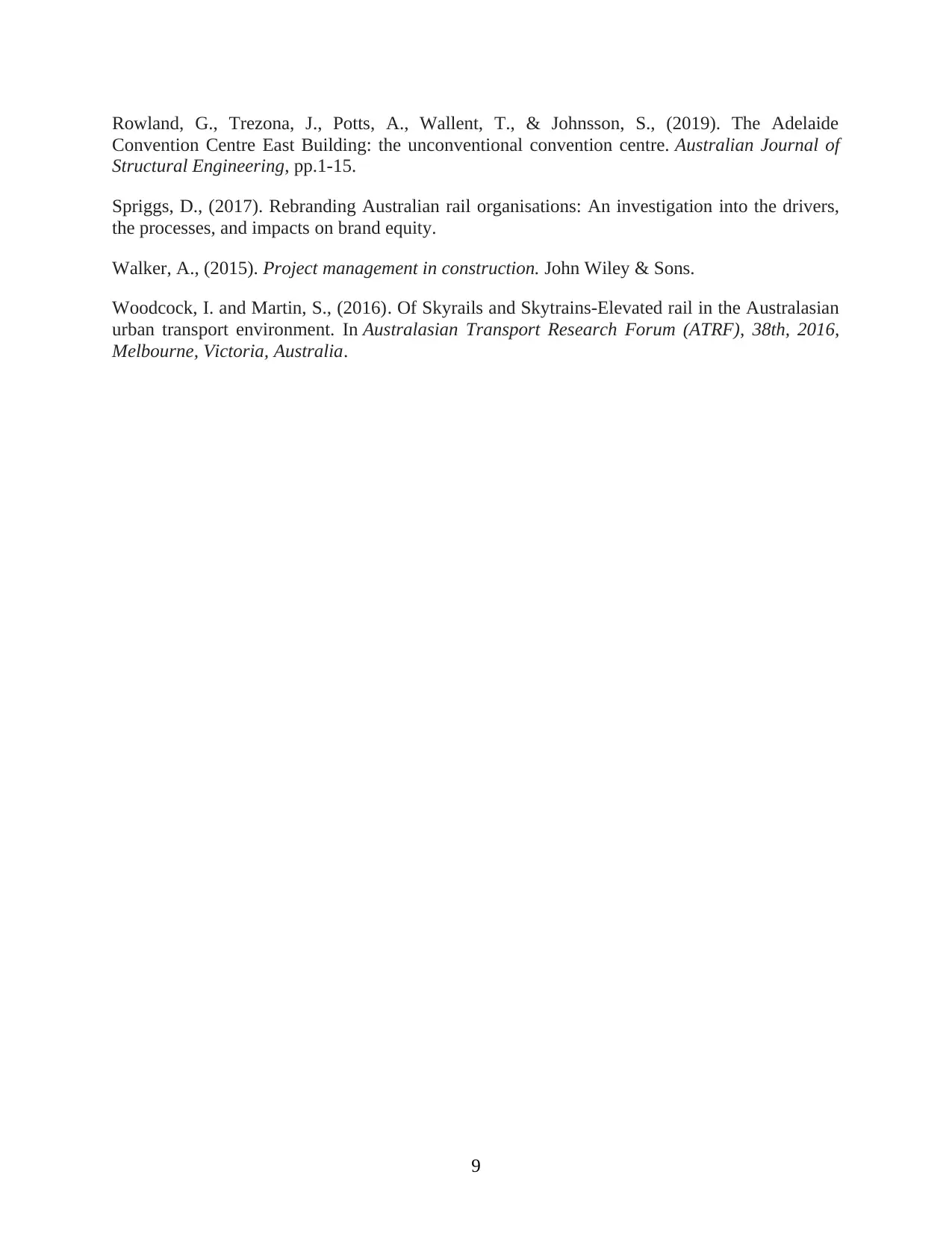
Rowland, G., Trezona, J., Potts, A., Wallent, T., & Johnsson, S., (2019). The Adelaide
Convention Centre East Building: the unconventional convention centre. Australian Journal of
Structural Engineering, pp.1-15.
Spriggs, D., (2017). Rebranding Australian rail organisations: An investigation into the drivers,
the processes, and impacts on brand equity.
Walker, A., (2015). Project management in construction. John Wiley & Sons.
Woodcock, I. and Martin, S., (2016). Of Skyrails and Skytrains-Elevated rail in the Australasian
urban transport environment. In Australasian Transport Research Forum (ATRF), 38th, 2016,
Melbourne, Victoria, Australia.
9
Convention Centre East Building: the unconventional convention centre. Australian Journal of
Structural Engineering, pp.1-15.
Spriggs, D., (2017). Rebranding Australian rail organisations: An investigation into the drivers,
the processes, and impacts on brand equity.
Walker, A., (2015). Project management in construction. John Wiley & Sons.
Woodcock, I. and Martin, S., (2016). Of Skyrails and Skytrains-Elevated rail in the Australasian
urban transport environment. In Australasian Transport Research Forum (ATRF), 38th, 2016,
Melbourne, Victoria, Australia.
9
1 out of 11
Related Documents
Your All-in-One AI-Powered Toolkit for Academic Success.
+13062052269
info@desklib.com
Available 24*7 on WhatsApp / Email
![[object Object]](/_next/static/media/star-bottom.7253800d.svg)
Unlock your academic potential
Copyright © 2020–2025 A2Z Services. All Rights Reserved. Developed and managed by ZUCOL.





